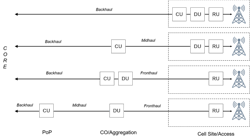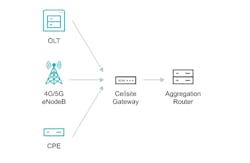5G opens a broad range of new services and revenue opportunities for mobile network operators (MNOs). While there is a real buzz around 5G from consumers, new revenue streams will come more from enterprises connecting things than from end-users connecting devices. IoT, smart cities, and connected cars are just the tip of the iceberg as to what is possible with 5G. Of course, this is not by accident; the standards were written to efficiently connect things ranging from small, low-power sensors to entire enterprise locations.
Obviously, 5G is a major change from 4G, and new network architectures will be needed to realize these opportunities. When we look beyond the radio access network (RAN) itself, it is clear that 5G services cannot be delivered without a robust transport network, which is the glue that holds together the disaggregated RAN components. While more bandwidth must be accommodated, 5G deployment will drive changes that will redefine the service edge.
Four key drivers
When planning 5G deployments, operators must consider four key drivers for the RAN transport network:
1. There will be many more cell sites to connect. 5G’s use of spectrum and small-cell sites means many more cell sites to connect. The spectrum used on 5G determines the area covered by a cell site (see Figure 1). For example, one low-band (600-700 MHz) tower can cover hundreds of square miles with speeds that range from 30 to 250 Mbps. A mid-band (2.5/3.5 GHz) tower covers a several-mile radius with 5G that currently ranges from 100 to 900 Mbps. Lastly, a high-band (millimeter-wave/24-39 GHz) tower covers a 1-mile or smaller radius while delivering roughly 1- to 3-Gbps speeds.
2. There will be much more bandwidth needed. 5G connections in the gigabit range get a lot of attention. The existing transport networks were not designed to handle the cumulative impact of this much bandwidth from the users. As customers take advantage of the greater bandwidth in 5G, the transport network will need to scale to handle the increased aggregate traffic. New spectrum, coupled with antenna technology like MIMO, make it possible for 5G speeds up to 3 Gbps for millimeter-wave. That is a major increase from the average 4G speed of 35 Mbps in the U.S. now.
The issue is not just the individual connections, but the total bandwidth from a cell site. How much bandwidth will come from each 5G cell site is complex. However, there is guidance for the transport network. NGMN did a comparison of 4G to 5G New Radio (NR) sites. They found that where a 1-Gbps interface from the cell site would suffice in 4G, the 5G NR would require at least a 10- or more likely 25-Gbps interface.1 However, services like enhanced mobile broadband (eMBB) offer up to 10 Gbps per location, so the likelihood is that the bandwidth will be much higher for some cell sites. In fact, the IEEE 1914.1 standard for transport assumes that the network interface in a fronthaul connection will be at least 100 Gbps.
It should be noted that the 5G transport networks will be IP based. Many operators plan to take advantage of this to converge their various networks. Having one physical infrastructure to support the full range of services makes great economic sense. With 5G, both the core and the access network can be converged. The same fiber plant that connects cell towers can also handle business and residential wireline services, which puts even more bandwidth and different services on the transport network.
3. Disaggregation and virtualization. In 4G LTE, the RAN functions could be disaggregated into the remote radio head (RRH) and the baseband unit (BBU) for cloud RAN (C-RAN) implementations. This allows the operator to move the BBU to a centralized location away from the cell tower (such as a central office). This disaggregated approach has tangible benefits. C-RAN showed that significant operational and capital expenditure reductions can be achieved with virtualization compared to traditional equipment deployments. In fact, a trial from China Mobile showed a 53% reduction in opex and 30% savings in capex.2
The 5G standards take full advantage of this disaggregated approach but break down the RAN functions differently. 5G RAN consists of the radio unit (RU), the distributed unit (DU), and the centralized unit (CU). The DU and CU can be implemented as software on commodity hardware using virtualization. Approaches like network function virtualization provide a holistic approach to managing these virtual components. Virtualization is popular because it keeps costs low while enhancing the agility needed to deliver services quickly and efficiently.
Of course, these components must be connected. The 5G standards from 3GPP define the various ways that the RAN functions can be disaggregated with standardized interfaces called functional splits. While the RU is at the cell tower, there is flexibility in placing the DU and the CU that has a major impact on the transport network.
Functional splits are a complex topic. While there are relative merits in the different functional splits, it appears that the consensus is the combination of splits 7.2 and 2 will be the dominant implementation. Split option 7 (particularly 7.2) keeps the cost of the RU low. That may be best suited where there are large numbers of small-cell sites. Split option 2 places complexity at the RU so it increases the RU costs. The bottom line is that the transport network will need to support the requirements dictated by the choice of splits. Each option has different impact on the network.
This can be simplified to a degree for our purposes. As we see in Figure 2, a fronthaul refers to a configuration where the DU and RU are physically separated. Midhaul refers to the connection between the DU and the CU while backhaul is for the connection from the CU to the core. Each of these has specific requirements for the network, especially for latency. For example, fronthaul latency must be less than 100 µsec so a DU can support RUs up to 10 km away.
In addition to revenue-generating services, operators will need compute that meets the latency requirements of implementations like the RU to DU connection in fronthaul. 5G operators need computing resources closer to cell towers and the network edge to run their virtualized network functions. There is a synergy with edge computing because the same facilities can also be used internally. ETSI’s Multi-Access Edge Computing (MEC) defines an edge computing ecosystem as one that works well with 5G. It is an open framework for applications and services that are tightly coupled with the RAN via open interfaces to integrate software services into wireless networks. Therefore, the same edge facilities and resources can be used to support both business edge applications and MNOs’ own virtualized network functions.
Fundamental shift in the service edge
These drivers are causing a fundamental change to the edge network. The capacity of the transport network is increasing as the number of cell sites doubles with the bandwidth per site going up by as much as an order of magnitude. The complexity is also growing as new 5G services, virtualization, and convergence all have different requirements, such as latency. More complex services, like network slicing, are coming and they will need virtualization for all network functions.
The service edge must now be much closer to the customer. We traditionally think of the service edge in an IP network as where the router delivers a service such as a VPN. In fact, the provider edge (PE) router for MPLS was typically in a point of presence in a major metropolitan area. This is actually “behind” the locations, like central offices, that will house the DU and edge computing infrastructure. Thus, routing must move in front of the location that houses edge computing and virtualized network functions.
Thus, the 5G transport network will need new routers to connect the cell towers and ensure the service requirements, like latency, can be met. Unlike routers used in 4G backhaul, these platforms will have to handle much more bandwidth, up to 300 Gbps. The software will have to be capable of ensuring the appropriate service levels for a range of applications. Open and disaggregated approaches will be needed to both keep costs low and enable innovation using automation and programmability.
Innovation will need to encompass virtual routing so that the transport network can match the service agility that virtualization will enable throughout the rest of a 5G network. RAN sharing, convergence in the fronthaul, edge computing, and network slicing all benefit by having dedicated routing. Like all other uses of virtualization, this will keep costs low while delivering services and revenue faster.
References
1. NGMN: 5G RAN CU - DU Network Architecture, Transport Options and Dimensioning v 1.0.
2. “C-RAN: The Road Towards Green RAN,” China Mobile Research Institute.
Hugh Kelly is vice president of marketing at Volta Networks.
About the Author
Hugh Kelly
Vice President, Marketing at Volta Networks
Hugh Kelly is vice president, marketing at Volta Networks.



